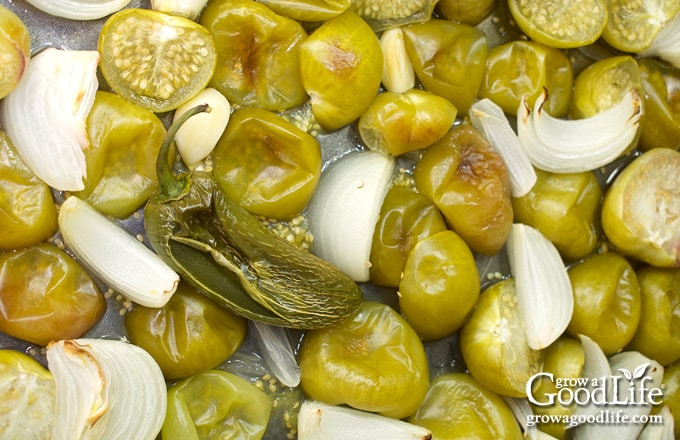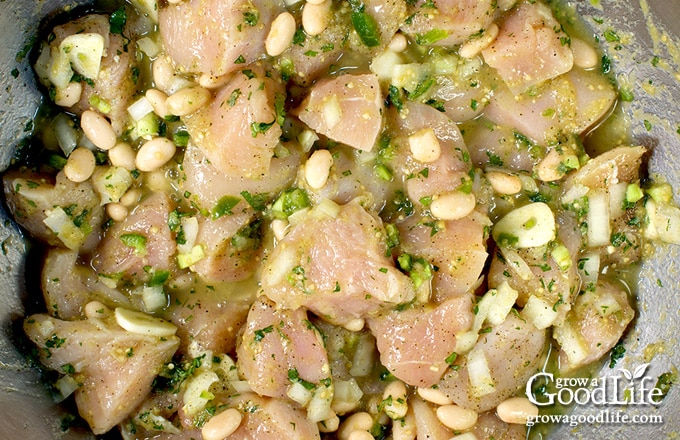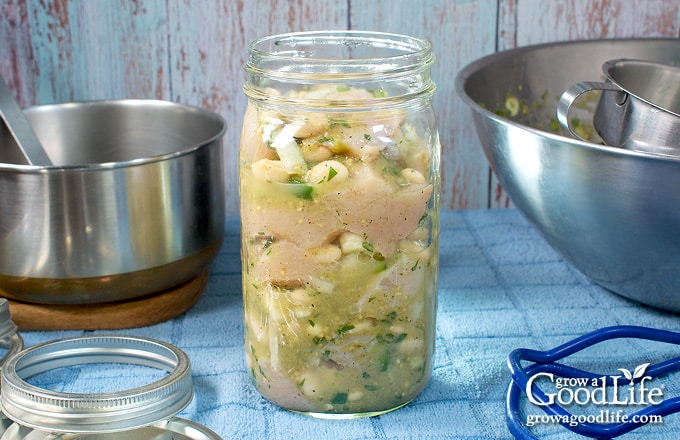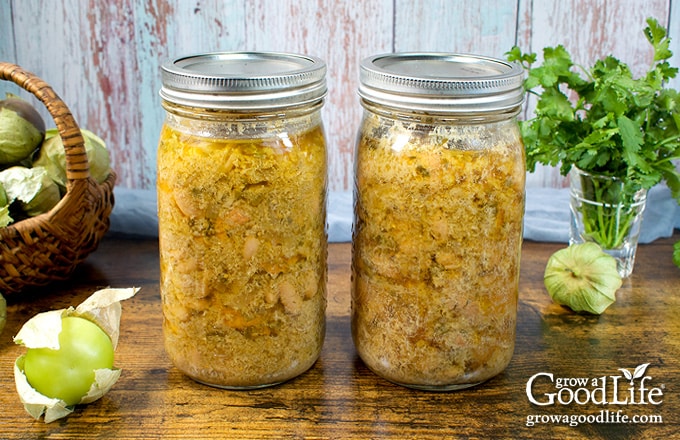Imagine a pantry stocked with jars of chicken combined with zesty green chile verde, providing a hassle-free solution for speedy and delicious meals. Learn how to home can chicken chili verde with this easy recipe.
Are you looking for a hearty and flavorful meal that is easy to prepare and can be enjoyed whenever you want? Then look no further than home-canned chicken chili verde! This recipe offers the convenience of a quick and easy meal and provides a delicious flavor that will satisfy your taste buds.
In this article, we’ll show you how to can chicken chili verde at home, step-by-step, so you can open a jar, heat it, and enjoy this tasty meal anytime. Keep reading to learn more!
About the Ingredients
Home canning meals in a jar provides such an easy way to get dinner on the table quickly. This chicken chile verde recipe is made with boneless chicken, white beans, green onions, and jalapeno chilies, tossed in a flavorful roasted tomatillo salsa verde, then packed into jars and processed in a pressure canner for shelf-stable jars that are ready to heat and eat any time.

Salsa Verde: I have included the ingredients and directions for making enough salsa verde for this recipe, but if you happen to have home canned Tomatillo Salsa Verde on the shelf, feel free to use it for this recipe to save some time.
Chicken: Either boneless chicken breasts or chicken thighs will work for this recipe. If you are using previously frozen chicken, thaw it in the refrigerator overnight and make sure it is completely thawed or it could cause the jars to break due to thermal shock.
Beans: The recipe calls for canned beans, which means these are completely rehydrated. Feel free to use any beans, such as pinto beans, navy beans, great northern beans, or another bean of choice. You can use store-bought, home-canned, or soak and cook dried beans ahead of time. You’ll need about 2/3 cups of dried beans to yield 2 cups of rehydrated beans. Just follow the “Prepare the Beans” step in this recipe: Canning Dried Beans.
Green Onions: The original recipe calls for sliced green onions, but you can substitute the same amount of chopped onions.
Jalapenos: If you happen to have a jar of pickled jalapenos on hand, you can use it for this recipe. You’ll need 4 tablespoons of sliced pickled jalapenos. Otherwise, substitute regular jalapeno peppers or an equal amount of another variety of green chili peppers, such as poblanos, serrano, or any sweet peppers, if you don’t like spicy foods
Cilantro: Fresh cilantro chopped. You can include the leaves and stems if you wish because the stems will soften when cooked. If you don’t like cilantro, feel free to leave it out.
Chicken Stock: The broth or stock is used to top off the jars after packing, so you won’t need a lot, about 1 quart or so. You can use water if you don’t have chicken stock on hand.
Steps for Canning Chicken Chili Verde
This canning recipe is the Chicken Chili Verde recipe from the Simple One-Jar Meals section in The All New Ball Book of Canning and Preserving.
Before you get started, reviewing this article on pressure canning at the National Center for Home Food Preservation website, along with the instructions for your pressure canner, may be helpful.
The full recipe can be found at the bottom of this article, but here are the detailed steps for preparing and canning chicken chili verde.
Step 1: Gather Your Kitchen Equipment
Before you begin, make sure you have all the essential kitchen tools and canning equipment ready to go. Here’s what you’ll need:
- Pressure Canner with canning rack
- Canning Jars: You’ll need 4 quart-sized jars or if you prefer smaller portions, 8 pint-sized canning jars
- Canning Lids and Bands: New lids for each jar, while the bands can be reused.
- Canning Tools: Jar lifter, canning funnel, ladle, and bubble popper
- Food prep gloves for handling hot peppers
- Food processor or blender to puree the sauce
- Basic kitchen equipment including a kitchen scale, large rimmed baking sheet, kitchen timer, knife, two cutting boards (one for meat and one for veggies), food thermometer, a large prep bowl, measuring cups and spoons, tongs, and plenty of clean kitchen towels
Give your canning jars, lids, bands, tools, and equipment a thorough scrub in hot, soapy water, and rinse well. Set the lids and tools aside on clean kitchen towels until you are ready to use them.
Place your jar rack into the pressure canner, and place the canner on a large burner of your stove. Measure and add the amount of water according to your canner manufacturer’s instructions: For Presto, you’ll need 3 quarts of water, while Mirro calls for 2 quarts, and All American suggests filling it 2 to 3 inches deep.
Fill the jars halfway with water and place them upright in the canner.
Step 2: Make the Salsa Verde Sauce
Preheat your oven to 425˚F. Remove the husks from the tomatillos and rinse them well to remove the sticky residue. Cut them in half and place them in a roasting pan or a rimmed sheet pan.
Wash the jalapeño pepper, trim off the stem, chop into pieces, and add to the pan. Peel and cut your onion into wedges, then add them to the pan. Peel the garlic and add it to the sheet pan.

Roast the vegetables in a preheated oven until everything is slightly softened and charred, about 15 to 20 minutes. Flip half way through so the vegetables roast evenly.
Once the veggies are finished roasting, remove the pan from the oven, and let it cool briefly for about 5 to 10 minutes.

Then, add the roasted vegetables and their liquid to a food processor or blender and pulse a few times to break them up. Add the lime juice, cilantro leaves, salt, pepper, cumin, and process until smooth. Measure 2 cups of verde sauce and set aside. You can add chicken broth or water if you are short. Set aside while you prepare the rest of the ingredients.
Step 3: Warm the Jars and Canner
Since we are raw packing the ingredients into the jars, warm the canner to just 140˚F. You can use a kitchen thermometer to check the heat. Bring the canner to a light simmer over medium heat, and then turn the heat down to maintain the temperature. Keep the canner and jars warm until you are ready to fill them.
Step 4: Prepare the Chili Ingredients
Trim the chicken to remove any fat, and cut it into 2 inch pieces. Use a kitchen scale to weigh the chicken and add 4 pounds of prepared chicken to a large prep bowl.
Drain and rinse the beans well until they stop foaming. Add 2 cups of beans to the bowl.
Wash the green onions well under clean running water, cut off the roots, and then slice the green onions. Measure 2 cups of sliced green onions and add them to the bowl.
Peel the garlic, slice it, and add it to the bowl.
Rinse the jalapenos well to remove any residue. Slide on a pair of food prep gloves and slice into rounds. Discard the stems, measure 4 tablespoons of sliced peppers, and add them to the bowl. After measuring, you can chop the slices into smaller pieces so their spicy flavor is evenly dispersed throughout the mixture.
Chop the cilantro, measure 1/4 cup of chopped fresh cilantro, and add it to the bowl. Add the salt, pepper, and mix to combine everything well.

Step 5: Fill the Jars
Add the chicken stock to a medium into a saucepan and bring it to a boil over medium-high heat. Keep it hot as you fill your jars.
While the stock is heating, prepare your work area by laying a dry kitchen towel on the counter and placing the canning lids, rings, tongs, bubble popper, and ladle nearby. Dampen a clean paper towel with a bit of vinegar to clean the rims of the jars before adding the covers.
Use the jar lifter to remove a warm jar from the canner. Drain the water in a separate bowl or the sink, and place it on the towel. Keep the remaining jars in the canner so they stay warm.
Place the canning funnel on the jar, then use tongs to pack the chicken mixture into the jar firmly. Leave a few inches at the top, and use the ladle to top off the jar with the hot broth, leaving a 1-inch headspace.
Work the bubble popper through the chicken to release any trapped air, then adjust the headspace again if needed by adding more chicken stock.
Wipe the rim with a damp paper towel to remove any residue. Center a lid on the jar, add the band, and screw it on until it is just fingertip-tight.
Use the jar lifter to place the jar back into the canner, and repeat with the remaining jars.

Step 6: Process in a Pressure Canner
Follow your pressure canner’s instructions for sealing, venting, and heating, then process the jars for the times indicated in the recipe below.
Once the processing time is over, turn off the heat and allow the pressure to return to zero. Then, remove the jars and set them on a dry towel to cool.
Keep the jars upright. Tilting the jars could cause food to spill into the sealing area of the lid and prevent the jar from sealing. Also, don’t touch the rings or test the seals yet. The jars need time to cool undisturbed to seal properly. Let them cool completely for 12 to 24 hours.
Test the seals after the cooling period. Refrigerate any that failed to seal and use up in a few days. Before storing your jars, remove the rings and wash them thoroughly with soapy water to eliminate any residue. Then label, date, and find a cool spot to store the jars of chicken chili verde. For optimal flavor, consume within 18 months.

Ways to Enjoy Canned Chicken Chili Verde
When you are ready to serve, open the jar, pour the chicken chili verde into a saucepan, and warm over medium-high heat for about 10 minutes. Season to taste with additional salt and pepper if needed, then ladle into bowls and garnish with shredded cheese, diced tomatoes, fresh cilantro, Mexican oregano, and a dollop of sour cream. Serve with tortilla chips and lime slices. Store any leftovers in the fridge and consume within several days.
Another way I enjoy using canned chicken chili verde is to shred it and use it as chicken enchilada filling wrapped in corn tortillas or homemade flour tortillas, topped with additional salsa verde and shredded cheese, and baked until bubbly. You can use this recipe as a guide: Chicken Enchiladas.
Chicken Chili Verde Canning Recipe
Are you looking for a hearty and flavorful meal that is easy to prepare and can be enjoyed whenever you want? Then look no further than home-canned chicken chili verde!
Sauce Ingredients:
- 1 pound tomatillos husks removed, rinsed well, and cut in half
- 1 medium jalapeno sliced
- 1 small onion cut into wedges
- 1 clove garlic
- 2 tablespoons bottled lime juice
- 1 tablespoon chopped fresh cilantro leaves
- 1/8 teaspoon ground cumin optional for flavor
Chili Ingredients:
- 4 cups chicken stock or water
- 4 pounds boneless chicken cut into 2-inch pieces
- 2 cups canned beans drained and rinsed
- 2 cups sliced green onions
- 4 cloves garlic sliced
- 3 medium jalapenos sliced
- 1/4 cup chopped fresh cilantro
- 1 teaspoons salt
- 1/2 teaspoon ground black pepper
Make the Salsa Verde Sauce:
-
Preheat the oven to 425˚F.
-
Add the prepared tomatillos, jalapenos, onions, and garlic to a rimmed sheet pan.
-
Roast the vegetables in a preheated oven until charred and slightly softened, about 15 to 20 minutes.
-
Remove the pan from the oven and let it cool briefly, about 5 minutes.
-
Add the roasted vegetables and their liquid to a food processor along with lime juice, cilantro, cumin, and process until smooth.
-
Measure 2 cups of verde sauce and set aside. You can add chicken broth or water if you are short.
Warm the Jars and Canner:
-
Place the jar rack into the pressure canner, and fill it with water per your canner manufacturer’s instructions: Presto is 3 quarts, Mirro is 2 quarts, and All American is 2 to 3 inches.
-
Fill the clean jars halfway with hot water and place them on the jar rack in the canner.
-
Bring the canner to a light simmer to 140°F for raw packing, heat for at least 10 minutes, and keep warm.
Prepare the Ingredients:
-
Add the chicken stock to a medium saucepan and bring to a boil over medium-high heat, and keep it hot.
-
Combine the prepared chicken with 2 cups of salsa verde, beans, green onions, garlic, jalapeno, cilantro, salt, and pepper in a large prep bowl. Mix well.
Fill the Jars:
-
Lay a dry kitchen towel on the counter. Use the jar lifter to remove a jar from the canner. Drain the water in a separate bowl or in the sink, and place it on the towel. Keep the remaining jars in the canner so they stay warm.
-
Use tongs to tightly pack the chicken mixture into the jar, leaving a little over one inch at the top, and then add chicken broth to fill the jar to 1-inch headspace.
-
Poke the bubble popper through the jar to release any air bubbles, and adjust the headspace again if needed.
-
Wipe the rim to remove any residue, center a lid on the jar, and screw on a band until it is fingertip tight.
-
Use the jar lifter to place the jar back into the canner, and repeat with the remaining jars.
Process in the Pressure Canner:
-
Place the lid on the canner and lock it. Leave the vent open, adjust the heat to medium-high, and bring the canner to a boil.
-
Once boiling, let the pressure canner to vent steam for 10 minutes, then place the pressure regulator on top of the air vent, and let the pressure rise.
-
When the canner has reached the correct pressure (10 pounds for weighted gauge or 11 pounds for dial gauge pressure canner), set a timer and process pint jars for 75 minutes, and quarts for 90 minutes at altitudes of less than 1,000 ft.
-
Adjust the pressure for your altitude if necessary (see chart below), and regulate the heat as needed to maintain a steady pressure.
-
When the processing time is complete, turn off the heat, and allow the canner to sit until pressure drops to 0. Once the canner is depressurized, let the canner cool additional 10 minutes before removing the lid.
-
Spread a dry towel on the counter, unlock the cover, and remove it by tilting the lid away from you so that steam does not burn your face.
-
Allow another 10 minutes for the jars to adjust to the change in pressure. If the jars are still boiling vigorously, let them sit in the canner for another 5 minutes or until the boiling slows.
-
Use the jar lifter to remove he jars from the canner and place them on the towel. Keep them upright, and don’t tighten bands or check the seals yet. Let the jars sit undisturbed for 12 to 24 hours to cool and seal.
-
After 12 to 24 hours, check to be sure the jar lids have sealed by pushing on the center. The cover should not pop up. The jar failed to seal if the top flexes up and down. Refrigerate it and use it within a few days.
-
Remove the screw-on bands and wash the jars in warm soapy water to remove any residue. Then label, date, and store the jars in a cool, dark place. Use within 18 months for the best quality. Yields 8 pints or 4 quarts.
All times are at an elevation of less than 1,000 ft. Visit whatsmyelevation.com to check your elevation and adjust the processing time if necessary. Make the following adjustments for altitudes greater than 1,000 ft:
- Dial Gauge Pints and Quarts at altitudes of 2,001 – 4,000 ft. increase pressure to 12 pounds, 4,001 – 6,000 ft. is 13 pounds, and 6,001 – 8,000 ft. is 14 pounds.
- Weighted Gauge Pints and Quarts at altitudes of 1,001 ft. and above, increase pressure to 15 pounds.
Serving: 1cup | Calories: 110kcal | Carbohydrates: 13.4g | Protein: 10g | Fat: 2.3g | Saturated Fat: 0.6g | Cholesterol: 22mg | Sodium: 230mg | Potassium: 311mg | Fiber: 2.7g | Sugar: 1.5g | Calcium: 82mg | Iron: 2mg
Grow a Good Life Guide to 40+ Meals in a Jar Pressure Canning Recipes
In this eBook, you will find 50 pressure canning recipes, including 44 meals, along with homemade stocks and bone broths. Recipes include soups, stews, chilis, beans, beef, pork, and poultry. Explore the world of preserving delicious home-cooked meals for all seasons.






